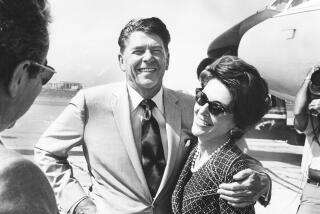Celebrating Ronald Reagan the centrist
From Sacramento -- — Call me the skunk at the picnic, but as conservatives celebrate Ronald Reagan’s 100th birthday, I’ll remind them that their icon often governed as a moderate.
Reagan talked like an unbending small-government ideologue, but in Sacramento and Washington he acted as a flexible whatever-size-fits pragmatist.
Those types of Republicans are in very short supply today and don’t seem to exist at all in leadership positions.
For that reason alone, all of us should be commemorating the centennial of Reagan’s birth.
That and the fact his upbeat personality transcended partisan politics. He certainly was, at his core, a conservative, but a non-threatening one to the millions of Democrats who continually voted for him.
Reagan, I suspect, would have mirrored much of America on Sunday: glued to the Super Bowl. He played college football and proudly portrayed the legendary George Gipp in the 1940 movie “Knute Rockne — All American.” The Gipper would have regarded it a superb birthday gift that his 100th fell on Super Sunday.
That’s the warm All-American president we can all celebrate, someone I came to greatly respect while covering him for 20 years in Sacramento and Washington.
But it’s also important to remember his pragmatism while disciples on the right extol his ideology at birthday events all over the country.
“He was always looking for a conservative solution, but when one wasn’t available he would go with what was necessary,” recalls Kirk West, a top official in Gov. Reagan’s administration. West, who later became president of the California State Chamber of Commerce, sat in on Reagan cabinet meetings.
“He had a big-tent philosophy that moderates in the party were not to be expelled. He was able to bring in all the party elements and work together. I’d classify him as a conservative, but to me the word conservative means to conserve — to conserve the institutions.”
Contrast this with today’s California GOP that tries to purge any Republican politician who dares to cast a vote to raise taxes.
Reagan knew it was his duty as chief executive to conserve the institution of government, even as he constantly talked about shrinking it but never could.
Sacramento definitely could benefit today from Reagan’s pragmatism and politics. He’d solve the $25-billion budget deficit and not lose a minute’s sleep. He would cut spending, but also raise taxes without hesitation.
That’s what he did his first year as governor in 1967. Faced with red ink left by Democratic Gov. Pat Brown, Reagan raised taxes by nearly $1 billion, equal to roughly 30% of the state general fund, still a modern record.
During Reagan’s tour in Sacramento, the maximum income tax rate increased from 7% to 11% and more people were shoved into higher brackets. Corporation taxes nearly doubled. The sales tax climbed. So did the tax on banks. Some of this paid for property tax relief.
George Steffes, who later became a successful business lobbyist, was a legislative liaison for Reagan.
“When Reagan was facing the same kind of budget deficit that they are today,” Steffes says, “he knew what anybody with half a brain knows: You can’t balance a budget without new revenue.”
Reagan did try to control spending. The governor admonished his staff that he would veto any bill that required increased funding. But he had soft spots.
Steffes remembers when a liberal Democrat pushed through a bill adding hemophilia to the list of ailments qualifying for treatment under the state’s Crippled Children Services Program.
“Everyone on the staff was saying, ‘You’ve got to veto the bill. It costs extra money and will add to the deficit,’ ” Steffes says. “Reagan opened the file, read through it and said, ‘I want to ask all of you a question: If we have a crippled children’s program, how can we say that hemophiliacs are not part of it?’ He signed the bill.”
Other bill signings: The most liberal abortion law in America — he later regretted it — and collective bargaining rights for local government workers.
Reagan’s signature achievement in Sacramento was welfare reform, a pragmatic compromise negotiated with Democratic Assembly Speaker Bob Moretti of Van Nuys. “I don’t like you and you don’t like me,” Moretti famously told Reagan. “But I don’t have to like you to work with you.”
Actually, they wound up liking each other. Their deal tightened welfare eligibility and cracked down on fraud, but also increased benefits for the “truly needy” — as Reagan called them — while guaranteeing annual cost-of-living increases. A good conservative-liberal blend.
On the environment, Gov. Reagan was practically a liberal. He once led a pack train into the high Sierra to declare the spectacular John Muir Trail and Minaret Summit, south of Yosemite, off limits to highway builders.
He and Republican Gov. Paul Laxalt of Nevada set aside their hostility toward centralized, intrusive government and created a bi-state agency to control growth at pristine Lake Tahoe. Reagan blocked dam building on the Eel and Feather rivers. He signed legislation creating the California Air Resources Board, leading to the nation’s first tailpipe emissions standards.
As president, Reagan turned to the right on the environment.
But on taxes? He did cut them significantly his first year. Then he later raised them and jacked up spending for a good cause: to overwhelm the Soviet Union in an arms race and end the Cold War. That’s pragmatism.
Bring back Reaganomics to Sacramento. It worked pretty well for all of us, including Reagan and the Republican Party.
More to Read
Sign up for Essential California
The most important California stories and recommendations in your inbox every morning.
You may occasionally receive promotional content from the Los Angeles Times.











